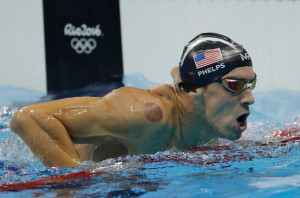Cupping Gilbert in AZ.
What Is Cupping Therapy?
Have you ever seen an Olympic swimmer with circular dark markings up and down his or her back and wonder what did he or she do to themselves and why? Chances are they have received a therapeutic cupping session.
So what is cupping therapy, and why would anyone want to do it? It looks painful, right? Cupping has been around for thousands of years dating back to early Egypt, China and Greece. It then spread through parts of Africa and Europe and was used by the natives of America.
Over the years, China has provided extensive research on the effectiveness and benefits of cupping, and currently uses this method in hospitals. In fact, the most prevalent use of cupping therapy has been in Traditional Chinese Medicine (TCM), but has now been adapted for other health care modalities including massage and chiropractic therapy.
Cupping is not reserved for athletes but is a therapy used by all walks of life to relieve muscle tension, backaches, stiff neck and shoulders and other challenges brought on by stress, work and daily life.
In ancient times, tribes utilized animal horns, bamboo, bones, nuts, seashells and gourds as suction devices to purge bites, infections and skin lesions from the body. Ancient healers even used this method on the body to draw out evil spirits. Currently, the cup is usually made from bamboo, glass or plastic and is most extensively used in TCM. Although there are several ways to facilitate stationary cupping therapy, fire cupping is most traditionally used. By quickly heating the inside of the cup with fire, suction is created when placed on the skin. Typically, 4 to 6 cups are used adhering to the skin for about 15 to 20 minutes. According to Acupuncture Today, “The negative pressure created by the suction stimulates the local acupuncture point, this increases the Qi and blood flow through the meridian to loosen up tight muscles, to relieve pain, and to detoxify and re-balance organ function.”
Massage cupping is another way of facilitating and is commonly used by practitioners of the western healing arts. Plenty of oil is needed to glide the cups over the skin in a smooth, consistent movement. The suction and negative pressure created by massage cupping releases rigid soft tissue, breaks up and drains excess fluids and toxins, loosens adhesions and lifts connective tissue, and brings blood and lymph flow to stagnant skin and muscles.
Stationary and massage cupping are most commonly used on the back, neck and shoulders. But by adjusting the size of the cups, this therapy can be used almost anywhere on the body including the feet and face.
Why Do You Get Marks or Skin Discoloration? Does It Hurt?
Stationary cupping, when the cups are left on the skin for a length of time, can leave rings and circles due to toxins and blood moving to the surface. This process can create some discomfort or pain as it creates a vacuum suctioning up the skin. The pressure influences the intensity level, however many describe the sensation as a slight pinch. Some marks can be darker than others, the darker the color the more effective that cupping point was for the client. Results are immediate and lasting, with the marks and discoloration fading in about a week. Despite any initial discomfort, many recipients describe cupping as relaxing and therapeutic. The pulling action engages the parasympathetic nervous system allowing, deep relaxation throughout body.
What Are the Benefits?
- Deep tissue work and release without discomfort
- Moves stagnation and drains fluid
- Relieves inflammation
- Nervous system sedation
- Breaks up and expels congestion
- Stretches muscle and connective tissue
- Loosens adhesions
- Pulls blood supply to the skin
- Facilitates movement of the Qi/Chi and blood systematically and locally
- Dispels wind, damp and cold to treat muscle and joint pain, stiffness and arthritis
- Strengthens the immune system by promoting the flow of lympatic fluid
- Treats excess heat conditions, fever, stress, depression and anxiety
- Cleans blood and lymph and helps to balance pH levels
How Long Does a Session Take and How Much Does It Cost?
Cupping therapy can last anywhere between 15 to 60 minutes. An example of a one hour session: 15 to 20 minutes of massage, 5 minutes to apply the cups, 15 to 20 minutes of the cups being stationary on the skin, 2 minutes to remove the cups and 15 to 20 minutes of massage.
Cupping therapy is priced similarly to a traditional massage session. It can range from $30 to $150 depending on the duration of the session and the practitioner being used. At spas, cupping is sometimes offered as an added service to a traditional massage for an extra $5 to $15 on top of the massage price.
What are Some Other Cupping Treatments?
- Cellulite cupping treatments: The pressure applied promotes lymphatic drainage, stimulates circulation, loosens connective tissue and adhesions, and clears toxins.
- Spa cupping treatments: Added to topical body treatments, cupping enhances absorption of the product and assists in drainage of stagnant fluids.
- Facial cupping: Small cups vacuum and lift facial tissue, mimicking the pumping movements of lymphatic drainage. It increases circulation to the skin, increases nutrients brought to the epidermis, softens scar tissue, plumps lines and wrinkles, reduces muscle tension and tightness and relieves inflammation.
- Pedi-cupping: Accompanies reflexology and is used for plantar fascial release.
- Sports cupping: Used for maintenance, pre- and post-event injuries, detoxification and recovery. It increases muscle endurance, circulation, lung capacity and lymph drainage.
Who Does Cupping?
Massage Therapists, acupuncturists, physiotherapists, sports therapists, nurses, doctors, chiropractors and other facilitators of the healing arts.
About The Author

